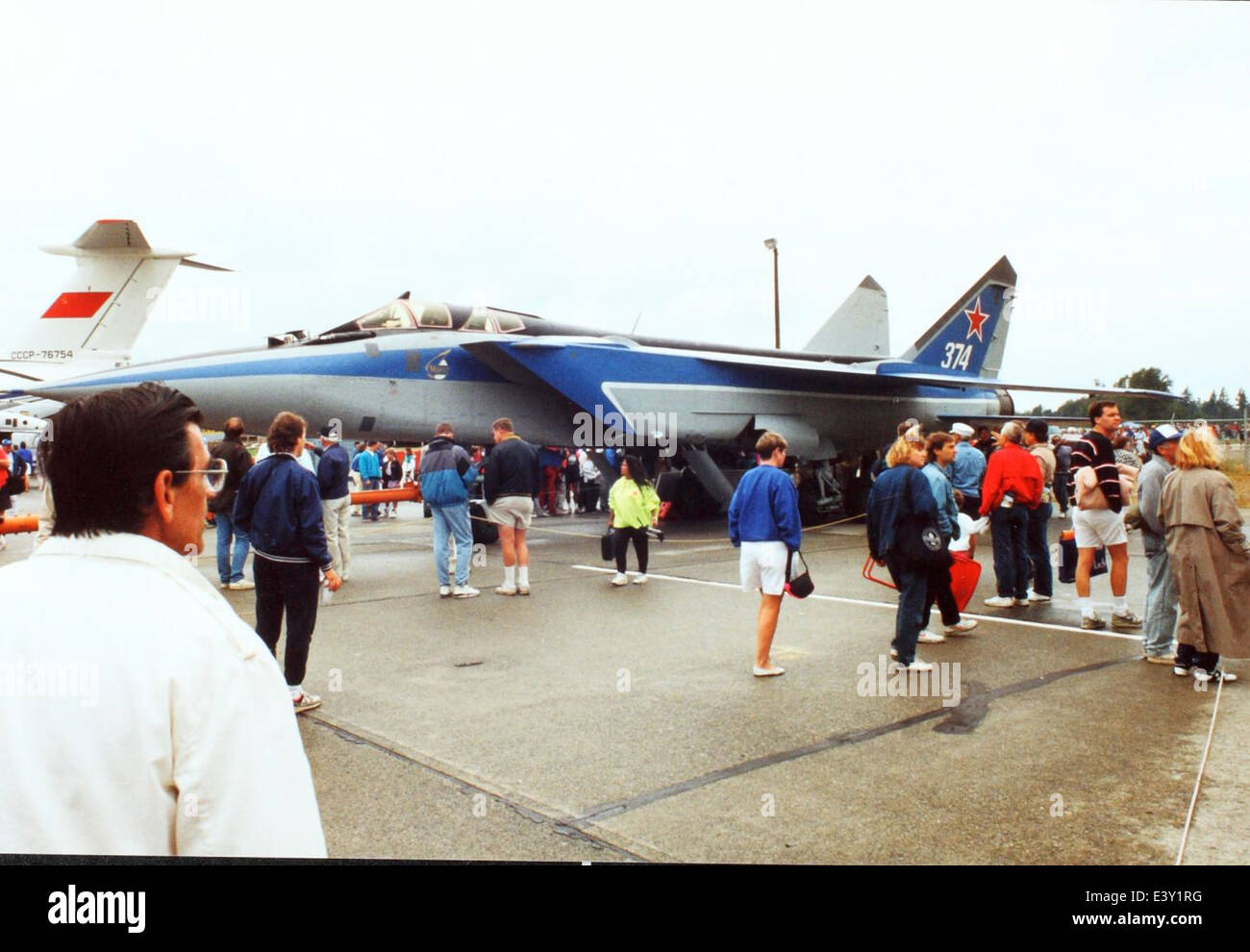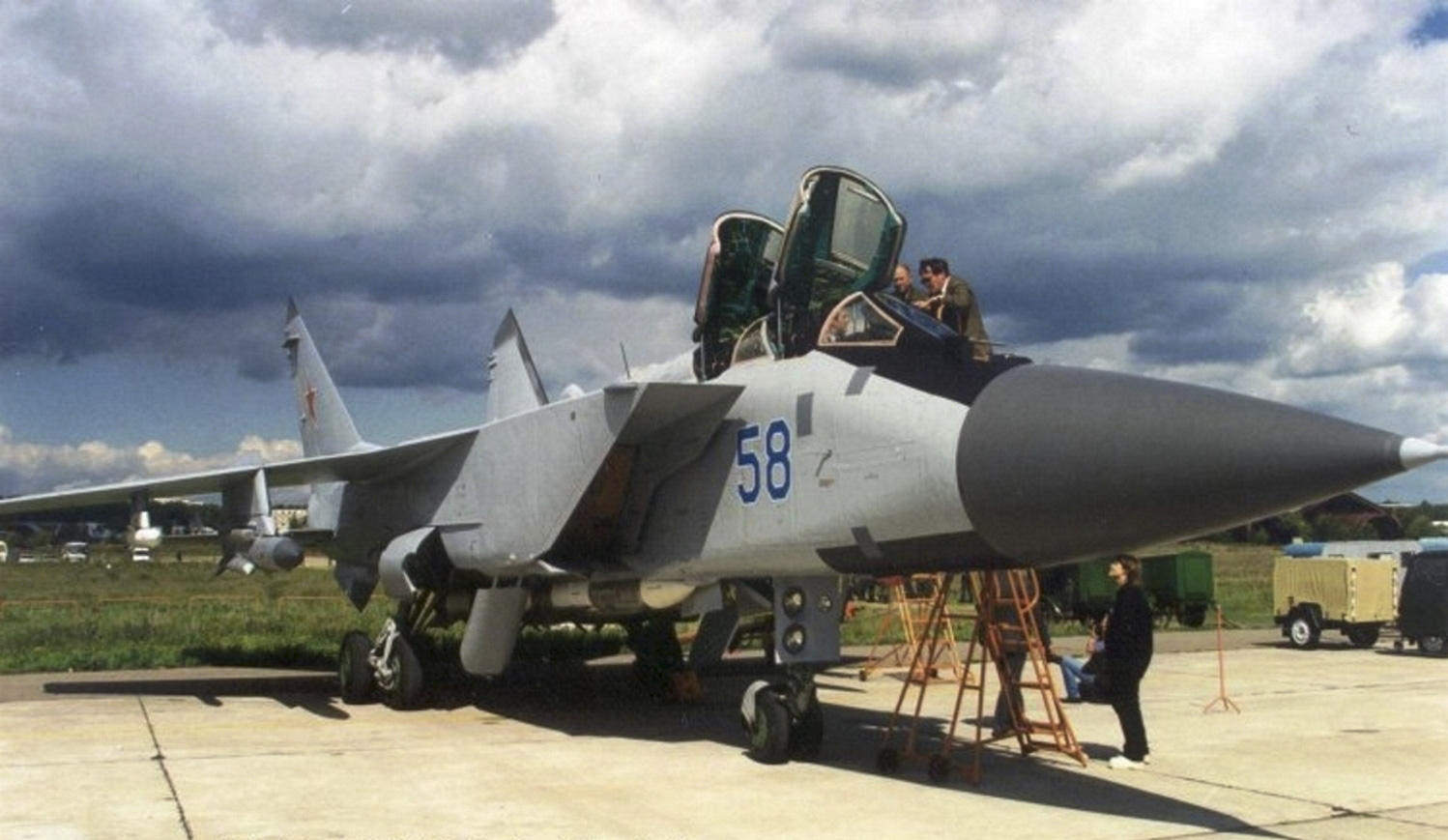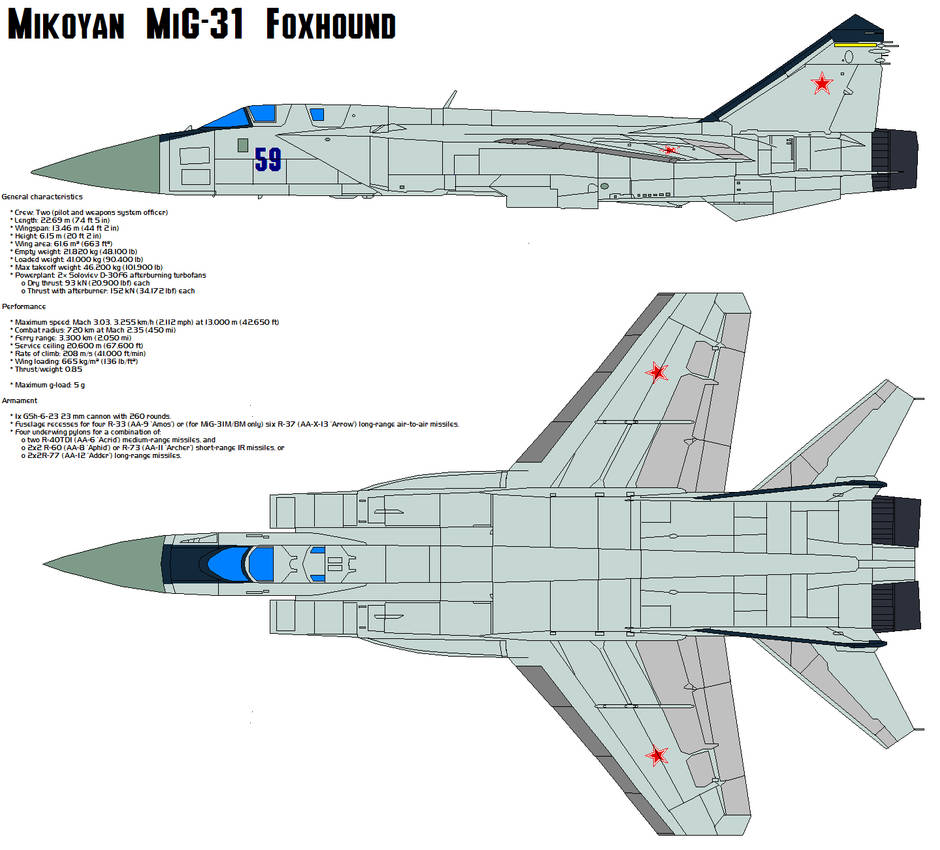Mikoyan Mig-31 Foxbat - The Mikoyan MiG-31 (Russian: Микоян МиГ-31; NATO reporting name: Foxhound) was a supersonic interceptor designed for use by the Soviet Air Force. The aircraft was designed by the Mikoyan Design Bureau as a replacement for the earlier MiG-25 "Foxbat". The MiG-31 is based on and shares design elements with the MiG-25.
It continues to be used by the Russian Air Force and the Kazakh Air Force, which were used in the 1991 Cold War and Cold War Soviet Union d. It was confirmed in 2020 when it was announced that the service hours at the existing airport would be extended from 2,500 hours to 3,500 hours.
Mikoyan Mig-31 Foxbat

The single-seat MiG-25 can achieve high speed, altitude and climb speed. However, it lacks maneuverability at intercept speed and is difficult to fly at low altitudes. The MiG-25's speed is normally limited to Mach 2.83, but can reach speeds of Mach 3.2 or higher at the risk of engine damage.
The Story Of The Soviet Pilot Who Defected To Japan With A Secretive Mig 25 Foxbat
Development of a replacement for the MiG-25 began with the Ye-155MP (Russian: Е-155МП) prototype, which first flew on 16 September 1975.
Although it bears a striking resemblance to the MiG-25, it has a longer fuselage to accommodate the radar operator's cabin and has many new design features. A key development center is the MiG-31's advanced radar, capable of both detection and downrange/shooting gas, as well as multi-target tracking. This gave the Soviet Union a remote-controlled interceptor of Western invaders (low-flying cruise missiles and bombers).
MiG-31 Like its predecessors, the introduction of the MiG-31 was surrounded by initial speculation and misinformation about its design and capabilities. West learned about the new interceptor from Lt. Viktor Belko, a pilot who defected to Japan in 1976 with his MiG-25P.
Belko describes the upcoming "Super Foxboat" with two seats and anti-cruising capabilities. According to his evidence, the new interceptor should have the same air intakes as the Mikoyan-Gurevich MiG-23, at least not the MiG-31 in the production range.
The Story Of The Mig 31 \
A group of four MiG-31 interceptors can control airspace with an average range of 800 to 900 km (500 to 560 mi).
Its radar has a maximum detection range of 200 km (120 mi) and a forward detection range of 225 km (140 mi).
Between 1976 and 1988, the first production batch of 519 MiG-31s, including 349 "basic types", was produced at the Sokol plant. A second batch of 101 MiG-31DZs was produced from 1989 to 1991. The final batch of 69 MiG-31B aircraft were produced between 1990 and 1994. The last 50 units were discontinued by the Kazakhstan Air Force after the dissolution of the Soviet Union. 40 aircraft from the "basic models" were upgraded to MiG-31BS standard.

Some upgraded systems found their way into the MiG-31 fleet, such as the multi-role MiG-31BM with upgraded avionics, new multi-function radar, manual thrust and stick controls (HOTAS), and liquid crystal display (LCD). Color. Performance display displays (MFDs), the R-77 missile and the Russian air-to-ground missile (AGM) such as the K-31 anti-radiation missile (ARM), new and more powerful computers, and today's digital. Data connection. A project to upgrade the Russian MiG-31 fighter jet to MiG-31BM standard began in 2010.
Mig 31 Foxhound Jet Fighter
According to the head of the Russian Ministry of Defense, Colonel Yuri Balako, the upgrade will increase the combat effectiveness of the aircraft several times.
Russian Deputy Defense Minister Yuri Borisov told reporters on April 9, 2015 that the Russian military will receive more than 130 upgraded MiG-31BMs, and the first 24 have already been delivered.
Russia plans to develop a replacement for the MiG-31 starting in 2019. This aircraft is called PAK-DP (PAK DP, per pony Avignoni Dalnego pere-Airspective Air).
Development of the new aircraft, particularly the MiG-41, began in April 2013.
Mig 31 Proved To Be The Best Russian Combat Aircraft In Ukraine
In March 2014, Russian test pilot Anatoly Kvochur said work had begun on a Mach 4-capable MiG-41 based on the MiG-31.
It was later reported that development plans for the MiG-31 replacement would begin in 2017, with the first aircraft delivered in 2020, and replacement maintenance service in 2025.
Like the MiG-25, the MiG-31 is a large twin-engined aircraft with side-mounted air lift racks, shoulder-mounted wings with an aspect ratio of 2.94, and twin vertical spoilers. Unlike the MiG-25, it has two seats, with the weapons system officer in the rear.

When flying at combat weight, its wing loading is limited and the weight-to-weight ratio is advantageous. The MiG-31 was not designed for close combat or fast turns.
Hasegawa 1:72 Scale Mikoyan Mig 25 Foxbat Plastic Scale Model
The MiG-31's wings and fuselage are stronger than those of the MiG-25, and it can fly supersonic at low altitudes. Like the MiG-25, its air conditioners are made primarily of nickel steel alloys to withstand dynamic heating at the aircraft's near Mach 3 airspeed. Steel alloy. , 16% titanium and 2% composite.
Its D30-F6 jet engines each have 152 kW of thrust and can reach a top speed of Mach 1.23. At temperatures above Mach 2.83, high-speed thrust-suction ratios can reach speeds above Mach 3, but frequent use at such speeds poses an unacceptable risk to engine and air life.
The MiG-31 was among the first aircraft to have a side-by-side radar, and as of 2013 was one of only two aircraft in the world capable of launching long-range air-to-air missiles.
The MiG-31 is the world's first fighter with the Zaslon S-800 passive electronic surveillance (PESA) radar. Its maximum combat range is about 200 km (120 mi), and it can track up to 10 targets and engage four of them simultaneously with Vympel R-33 missiles. The under-the-radar radar is equipped with an infrared search and tracking system.
The Modelling News: Construction Review Pt.ii: 1/72nd Scale Mikoyan Mig 25rbt Foxbat B From Icm
A secure database today. The RK-RLDN data link is for communication with the ground control center. The APD-518 database allows a squadron of four MiG-31s to automatically exchange radar data within 200 km (120 mi). It also benefits other aircraft with advanced avionics.
Guidance on MiG-31 sighted targets (maximum four (length) of each MiG-31 aircraft). A-50 AEW and MiG-31 aircraft can automatically switch antennas and targeting radars;
The MiG-31's navigation equipment includes the automatic control system SAU-155MP and the navigation system KN-25, two inertial systems and the IP-1-72A digital computer, a long-range navigation device. Electronic Radical NP (312) or A-331, Long Range Electronic System A-723. Long-range radio navigation is carried out by two systems: the seagull (similar to the Loran system) and the "track" (similar to the Omega system).

The APD-518 flight crew can share data received by several radars in different directions (active or passive analysis of radiation) and summarize the data. Targets can be viewed independently. All aircraft with APD-518 will have clear data, if not participating in the search.
Mikoyan Mig 31 Preparing To Take Off Wallpaper
The image shows how the four MiG-31s can be controlled up to 1,000 km (620 miles) away, and how the commander can send messages to the fighters.
The aircraft is a two seater with the rear seat controlling the radar. Although the cockpit is duplicated in the control compartment, it is normal for the aircraft to be flown from the front seat. Pilots fly the aircraft using the ctre stick and left hand thruster. The rear cabin has only two small viewing ports on the side of the engine. The location of the WSO (weapon system operator) in the rear cockpit makes flying more efficient, as the WSO is dedicated to radar operations and weapon deployment, thus reducing the pilot's workload and increasing efficiency. Both cockpits are equipped with zero/zero exhaust, allowing the crew to eject at any altitude and airspeed.
A group view of a MiG-31 from the 790th Fighter Command of the Kutuzov Aviation Regiment on the runway of the Khotilovo Air Base, Tver Region.
The MiG-31BM has a resolution of 282 kilometers (175 mi) and a target radar cross section of 5 square meters.
The Mikoyan Mig 31 (russian: Mukosh Muf 31; Nato Reporting Name: Foxhound) Is A Supersonic Interceptor
During Russia's invasion of Ukraine in 2022, MiG-31s reportedly shot down several Ukrainian aircraft, mainly using R-37 long-range air-to-air missiles. Due to its high speed and altitude, the MiG-31 was able to effectively outmaneuver the Ukrainian fighter because it did not have the size, speed or altitude.
The R-37M is the main threat to the Ukrainian Air Force from October 2022. The Ukrainian Air Force lacks fire-and-forget missiles. They rely on the R-27 missiles, the R-27ER and R-27ET; The R-27ET has a range of 60 miles. The Ukrainian pilot must illuminate the Russian aircraft with radar and guide the missile to the target. Russian pilots shot down active radar, fire and forget R-77s for them
Mikoyan mig 31 foxhound, mikoyan foxbat, mikoyan mig 31, mig 31 foxbat, mig 25 foxbat for sale, mikoyan mig 25 foxbat, mig 25 foxbat, mikoyan gurevich mig 21 fishbed, mikoyan gurevich mig 31, mig mikoyan, mig 31, mikoyan gurevich mig 25 foxbat
0 Comments